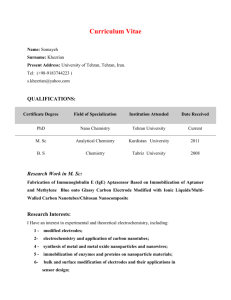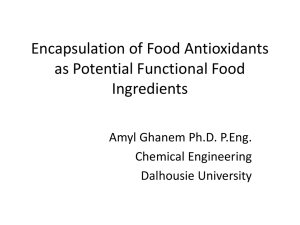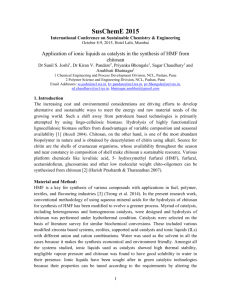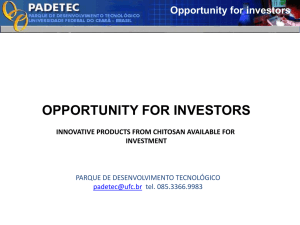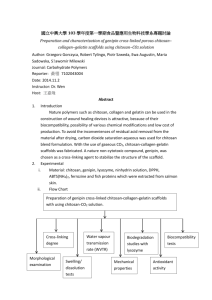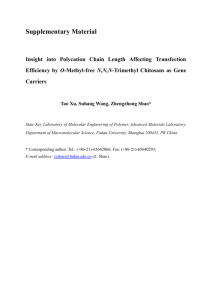CIFE Mumbai
advertisement
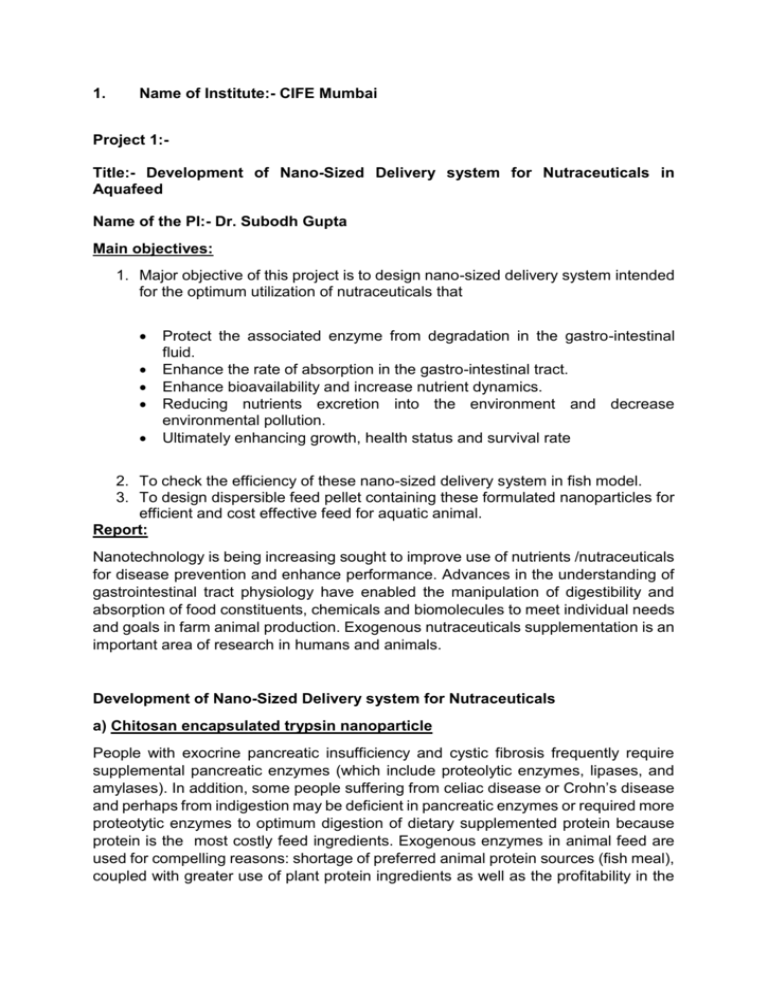
1. Name of Institute:- CIFE Mumbai Project 1:Title:- Development of Nano-Sized Delivery system for Nutraceuticals in Aquafeed Name of the PI:- Dr. Subodh Gupta Main objectives: 1. Major objective of this project is to design nano-sized delivery system intended for the optimum utilization of nutraceuticals that Protect the associated enzyme from degradation in the gastro-intestinal fluid. Enhance the rate of absorption in the gastro-intestinal tract. Enhance bioavailability and increase nutrient dynamics. Reducing nutrients excretion into the environment and decrease environmental pollution. Ultimately enhancing growth, health status and survival rate 2. To check the efficiency of these nano-sized delivery system in fish model. 3. To design dispersible feed pellet containing these formulated nanoparticles for efficient and cost effective feed for aquatic animal. Report: Nanotechnology is being increasing sought to improve use of nutrients /nutraceuticals for disease prevention and enhance performance. Advances in the understanding of gastrointestinal tract physiology have enabled the manipulation of digestibility and absorption of food constituents, chemicals and biomolecules to meet individual needs and goals in farm animal production. Exogenous nutraceuticals supplementation is an important area of research in humans and animals. Development of Nano-Sized Delivery system for Nutraceuticals a) Chitosan encapsulated trypsin nanoparticle People with exocrine pancreatic insufficiency and cystic fibrosis frequently require supplemental pancreatic enzymes (which include proteolytic enzymes, lipases, and amylases). In addition, some people suffering from celiac disease or Crohn’s disease and perhaps from indigestion may be deficient in pancreatic enzymes or required more proteotytic enzymes to optimum digestion of dietary supplemented protein because protein is the most costly feed ingredients. Exogenous enzymes in animal feed are used for compelling reasons: shortage of preferred animal protein sources (fish meal), coupled with greater use of plant protein ingredients as well as the profitability in the fish, poultry and pig sectors, which are compete for feed resources among themselves and also with humans. The innovative idea for nano-encapsulation of trypsin with chitosan is that as pancreas gland secretes trypsin as trypsinogen or in inactive form (zymogen) and will activate in gastrointestinal tract by proteolytic cleaving that converts to active trypsin to check autolysis and protect the delicate epithelial mucosa of gastrointestinal tract and usually in animal feed, we add active form. This nanoformualated trypsin proved that nanoencapsulation of trypsin not only protects the delicate epithelial mucosa but also improve the protein digestion in compare to bared form trypsin. Characterization of chitosan encapsulated trypsin nanoparticle (CE-Try-NPs) Chitosan nanoparticles (CNPs) were prepared based on the modified ionic gelation method (Calvo et al., 1997). These synthesized CNPs were used for the production of nanoencapsulated enzyme for oral delivery of exogenous enzymes in Labeo rohita fingerlings. Two different level of trypsin and 0.4% of chitosan were taken for nanoparticle preparation i.e., 0.4% chitosan with 0.01% trypsin and 0.02% (refereed as 0.01% CE-Try-NPs and 0.02% CE-Try-NPs respectively) presented in figures 1-3. Fig1: Particle size distribution of 0.4% CNPs (n=3) Fig2: Particle size distribution of 0.01% CE-Try-NPs (n=3) Fig3: Particle size distribution of 0.02% CE-Try-NPs (n=3) Zeta potential measurements The zeta potential of CNPs and CE-Try-NPs was measured. The measurement of zeta potential predicted about the stability of nanoparticle and presented in figure 4. Zeta potential (mV) Zeta potential (mV) Chitosan 0.01 Cnet 0.02 Cnet 0.4% CNPs 0.01% CE-Try-NPs 0.02%CE-Try-NPs Fig Fig 4: Zeta potential value of CNPs and CE-Try-NPs AFM results AFM analysis of the chitosan nanoencapsulated trypsin revealed that the nanoparticles exhibited spherical shape with a homogenous distribution (Figure 5 and 6). Fig 5: Three-dimensional image of 0.01%CE-Try-NPs Fig 6: Three-dimensional image of 0.02% CE-Try-NPs Histological study of intestine indicates safety of nanoencapsulated trypsin over its bare form Intestine histology of Labeo rohita fingerlings fed the control diet showed intact architecture (Fig 7A), and histology of 0.4%chitosan NPs-fed fish did not show much difference from control (Fig 7B). Intestinal tissues of fish fed with the 0.02% bare trypsinsupplemented diet showed broadened villi, marked foamy cells with lipid vacuoles, atrophied submucosal layer and muscularis(Fig 7C-1 and 7C-2). In general, villi were healthier in appearance and had improved morphological features after being fed chitosannanoencapsulated trypsin compared to bare trypsin. The villi were longer in fish fed with 0.01% chitosan nanoencapsulated trypsin (Fig 7D) than 0.02% chitosan nanoencapsulated trypsin, which slightly resembled the control group (Fig 7E). Fig 7:Intestine histology of fish fed control, 0.4% chitosan nanoparticles, 0.02% bare trypsin and and 0.01% or 0.02% nanoencapsulated trypsin containing diets (H&E, 40X). In control group (A), intestinal mucosa is lined by regularly-packed villi withcontinuous basement membrane. In 0.4% chitosan nanoparticles fed fish (B), mildly swollen apical surface of villi (1) are noticed. In 0.02% bare trypsin (C-1 and C2), broadened villi, marked foamy cells with lipid vacuoles (2), atrophied submucosal layer and muscularis (3) were evident. In 0.01% trypsin encapsulated in 0.4% chitosan nanoparticles (D), longer villi (4) with healthy apical surface (5) and improved morphological features besides continuous basement membrane are evident. Crypt depth was less in treated groups (6). Distinct mucin producing goblet cells (7) distributed along the villi in nanoencapsulated trypsin groups indicates better gastro-intestinal health. Villi in 0.02% trypsin encapsulated in 0.4% chitosan nanoparticles (E) resembled those in control group (A). Effectiveness and safety of dietary nanoencapsulated trypsin at half the dose rate (0.01%) (D) of bare trypsin (0.02%) (C-1 and C-2) is evident from healthier villi with more height and absorptive surface.doi:10.1371/journal.pone.0074743.g007 b) RNA-loaded chitosan nanoparticles Exogenous nucleotide supplementation during times of rapid growth and stress is preferred because de novo synthesis is insufficient and energetically a costly process. To overcome inefficient utilization of dietary nucleotides dueto intestinal cell repulsion and dependency on pH, an efficient controlled delivery system based on chitosan nanoparticles (NPs) was developed. Characterization of Chitosan and RNA-Loaded Chitosan NPs Comparison of the physical and chemical characteristics of the synthesized RNAloaded chitosan NPs (Table 1) indicated that as the proportion of chitosan increased, the size and so the zeta potential of the nanoparticles were increased significantly (P < 0.01). The optimum entrapment efficiency of RNA-loaded chitosan nanoparticles was found where chitosan to RNA ratio was 2:1; it was decreased where the ratio was 3:1. Particle size distribution of the different ratios of the chitosan and RNA is shown in Fig. (8A-C). Two dimensional (Fig. 8B-1) and three dimensional (Fig. 8B-2) images by atomic force microscopy of the RNA-loaded chitosan NPs revealed that the nanoparticles exhibited a spherical shape with a homogenous distribution. Table 1. Physico-chemical characteristics of chitosan nanoencapsulated RNA varying in chitosan to RNA ratio Chitosan:RNA Ratio¶ and chitosan Particle size Zeta potential Entrapment (nm) (mV) efficiency % Chitosan: RNA (1:0) (Chitosan 126.4±1.46 34.8±0.53 - blank) Chitosan: RNA (1:1) 250.1a±1.58 27.1a±0.62 61b±0.97 Chitosan: RNA (2:1) 287.1b±1.49 34.5b±0.49 73.5c±0.85 Chitosan: RNA (3:1) 326.8c±1.21 37.0c±0.46 56.5a±1.16 ¶Chitosan: RNA ratio was varied by using different chitosan concentrations (0.4, 0.8 and 1.2 percent) but keeping RNA concentration same i.e. 0.4 percent for all the combinations a, b, c Means of a physico-chemical character of chitosan: RNA nanoparticles bearing different superscript letters differ significantly (P < 0.01). Values represent means ± standard error of triplicate observations. Fig 8:Particle size distribution of nanoparticles and atomic force microscope (AFM) images. RNA-loaded chitosan NPs were prepared with varying ratios of chitosan to RNA such as 1:1 (A), 2:1 (B) and 3:1 (C). As NPs prepared with a chitosan to RNA ratio of 2:1 were used for further study, two-dimensional (B-1) and three-dimensional (B-2) images of these are shown. Performance, Body Composition and Organo-Somatic Indices The data on growth and performance (Fig. 9) indicated that feeding with plain chitosan NPs had no effect, but feedingbare RNA increased (specific) growth (rate) (SGR) and improved feed conversion (ratio) (FCR) as well as proteinefficiency (ratio) (PER). Nano-sizing by loading of RNA onto chitosan NPs further potentiated its nutritional benefits;which was evinced by significantly (P < 0.01) improved SGR (without effect on FCR and PER) at half the dose ofbare RNA. When the dose rate of RNA was the same, the productive efficiency in terms of SGR, FCR and PER withRNA-loaded chitosan NPs was significantly (P < 0.01) higher than bare RNA. The whole body mean per cent (n =3) protein (15.48±0.11 to 16.24±0.09), lipid (2.89±0.45 to 3.67±0.50) and ash (1.78±0.37 to 2.24±0.24) content was notsignificantly different among different groups. Feeding plain chitosan NPs had no effect on hepatosomatic index (HSI) and viscero-somatic index (VSI) (Fig. 9). There was no effect from RNA in bare form, but feeding thenano-sized form of RNA both at half the dose rate and at the same dose rate of bare RNA resulted in a significant increase (P < 0.01) in HSI. The RNA in bare form increased (P < 0.01), and nano-sizing had no further effect on GSI. Fig 9:Performance and organo-somatic indices of fish fed chitosan nanoparticles (NPs), bare RNA and RNA-loaded chitosan NPs for sixty days. Performance (A) and organo-somatic indices (B). Bars bearing different superscript letters differ significantly (P < 0.01). Values represent means ± standard error of triplicate observations. Abbreviations: Chitosan NPs (CtNPs), RNA-loaded chitosan NPs (RNA-CtNPs). Project 2:Title:- Fish gelatain based nanocomposite films for food packaging Name of the PI:- Dr. B.B. Nayak. Main Objectives: To develop natural polymer based biodegradable films and study their mechanical properties. To incorporate natural and synthetic nanomaterials improve the desirable qualities of the films. To study the protective effect of natural preservatives added in the films To evaluate the efficiency of the developed films for extension of shelf life of fish products Reports:Not Submitted

